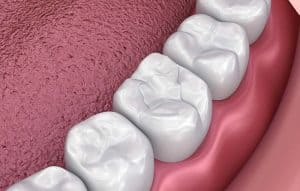What is the Best Tooth Filling?
There’s no such thing as the “best tooth filling” but the closest answer we can give is that it depends upon the clinical situation. When placing a filling, we consider (among other things) the patient’s ability to brush and floss, the location of the tooth (esthetic area or non-esthetic area) and the depth of the cavity.
Our blog post about tooth-colored fillings discusses colored (composite fillings or “white fillings”) vs. amalgam (sliver) fillings, and you might find that discussion helpful as a reference.
Three General Types of Fillings
White fillings
Best for esthetic areas of the mouth such as the front teeth or the premolars (the teeth “in the middle” – before the molars in the back) because we can match the color of the filling to the color of the tooth. White fillings are also good for very small cavities, where minimal drilling is required.

Silver fillings
Best for areas where there is already a history of a cavity because tooth has already been removed, if the patient has a hard time keeping their mouth open, or if the filling is in a non-esthetic area and is deep.
Glass ionomers
You may never have heard of glass ionomers before, but they are a third type of material that we often use. You can think of glass ionomers as a cross between silver fillings and white fillings. Glass ionomers do not require removal of significant tooth structure, come in multiple colors, adhere to the tooth, and uniquely – release Fluoride. We use these types of restorations for shallow cavities where esthetics are important, and we want Fluoride for a patient that may have a tendency to get decay, or have difficulty brushing and flossing.






